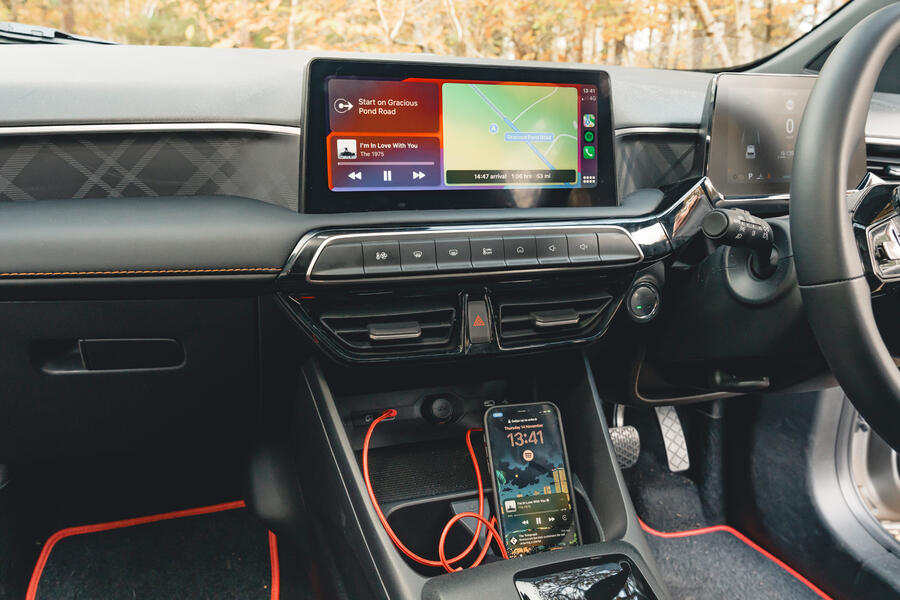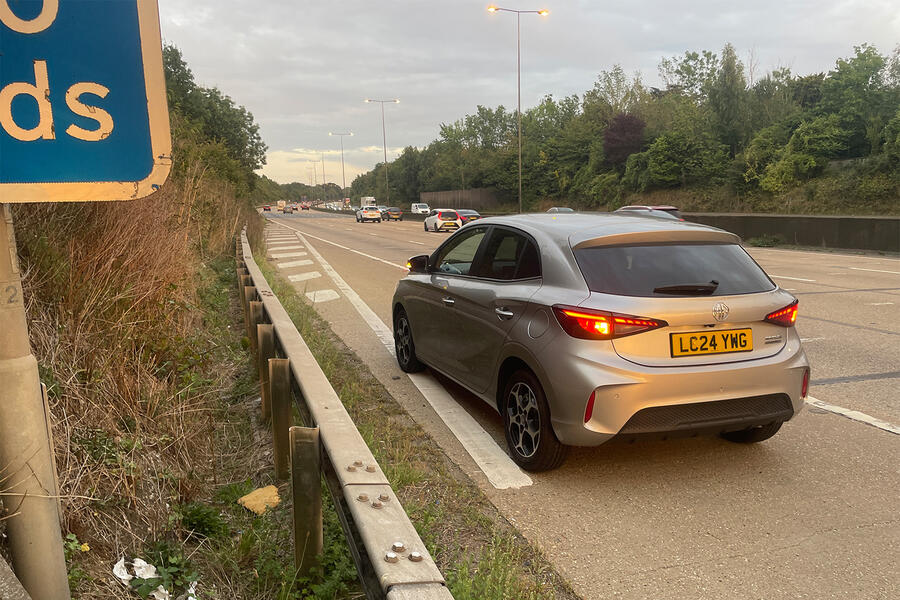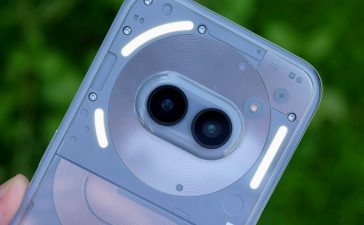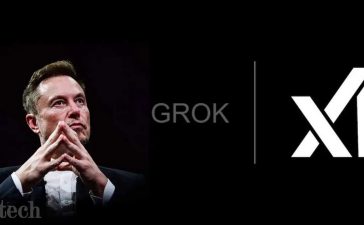Can this hybrid compete with the best superminis? Here’s our verdict
What am I, Autocar’s supermini correspondent? I’d be quite happy with that, actually, having previously run a generally fabulous Renault Clio E-Tech hybrid and then an endearingly honest petrol Dacia Sandero on our test fleet.
Now I’m trying the new MG 3 – a car on which I delivered Autocar’s first verdict back in May, and a very positive verdict at that. Well, MG did promise “everything about it was designed to put a smile on your face”.
The old 3 seemed a generation behind the competition even when I last drove it some six years ago, the justification being that it was one of the cheapest cars on sale. This new 3 is a wholly different proposition:
MG says it effectively skipped a generation, which checks out, and it’s now priced £4000 higher, putting it into Clio territory. And in terms of how it behaved on the road, my initial feeling was that it wasn’t notably inferior to the class leader.

Of course, though, living with a car every day can reveal hidden talents and flaws, which is why I will now be evaluating the 3 over an extended period.
Like that initial test car, my 3 is in Trophy trim, which adds extra advanced driver assistance systems (as required by regulators, unfortunately), LED headlights, a combination of faux-leather and fabric upholstery, heated front seats (yes then!), a heated steering wheel (oh, get in!), a 360deg camera, keyless ignition and automatic windscreen wipers.
That’s all on top of SE trim’s generous standard kit count, which includes a 10.3in touchscreen infotainment system with Apple CarPlay, Android Auto and sat-nav, a 7.0in digital instrument display, a six-way adjustable driver’s seat, rear parking sensors, electrically adjustable door mirrors and 16in alloy wheels.
It’s an almost identical spec to the entry-level Clio hybrid yet for £3500 less (although they are almost identical on a 48-month PCP finance deal at present, costing around £200 per month).

It really is amazing how much you get on affordable cars nowadays (and I would argue that an £18,495 starting price definitely still qualifies the 3 as such).
The extra-cost item on our car is the rather smart metallic silver paint, because MG simply doesn’t do options: you just pick a powertrain, one of two trim levels and a colour. Actually, in the 3’s case, you don’t even pick a powertrain, because it only comes as a hybrid (for now, at least; a cheaper pure-petrol model is apparently on the way).
This combines a naturally aspirated 1.5-litre four-pot petrol engine, a three-speed automatic gearbox, an electric motor and a small (0.92kWh usable capacity) battery. Combined outputs are put at 192bhp and 313lb ft, or in electric-only running there’s 134bhp and 184lb ft – significantly more than some perfectly usable EVs have.

I’m still unconvinced about the accuracy of that combined torque claim, even though the 3 can kick me up the backside with what is for a supermini hilarious strength.
It’s something I need to look into in greater detail. Certainly, the gearbox, while simpler than the mind-boggling multimodal unit in the Clio, isn’t what you would usually find, having so few speeds. It provides distinct waves of power delivery (one of them coming, confusingly and unhelpfully, at around 70mph), so perhaps the answer is somewhere therein.
In these tough economic times, the outstanding efficiency of the Clio was one of my favourite things about it, as it averaged 53.5mpg during our time together, against an official 65.7mpg. Given that the 3’s WLTP figure is a similar 64.2mpg, I’m relishing the prospect of still having some extra money left at the end of each month.
Everybody who has had a poke around this Trophy-spec interior has been impressed by the classy look and decent-quality feel – especially those with experience of the old 3.

I particularly like that, unlike in most Chinese cars (and, to be fair, many of the latest from other parts of the world), the touchscreen hasn’t absorbed all of the physical controls. In fact, it’s much more understated than most, including the Clio’s. Beneath said screen is a row of buttons for air-con functions, the infotainment system’s home page and the audio volume.
It’s just a shame that none of them is for adjusting the fan speed or internal heat, or indeed turning the heated surfaces on or off, and that you have to press the home button before the air-con button when Apple CarPlay is active (which itself irritates by requiring a wired connection), otherwise nothing happens. Oh well: you have to take what you can get these days.
A bigger disappointment is that the passenger’s seat doesn’t adjust for base height, only for angle and leg room, because it means either a 5ft-nothing or a 6ft-something passenger will always be in a suboptimal position (which wasn’t a problem in my high-spec Clio).

Similarly, it’s a shame that the 3’s rear bench doesn’t split in any way for folding – something I’ve always taken for granted – in order that I can take more than one person with me to Ikea.
Nevertheless, I’m still finding more positives than negatives about this car at the moment. I’m just puzzled why I haven’t seen another one on the road yet, six months after launch, especially given that there’s a big MG dealership in town.
Update 2
Oh no, oh no: I’ve only just got this car and already something has gone horribly wrong with it – and in rush hour on the M25, of all times and places.
I’m cruising in the MG 3 when it emits a beeping noise so loud that I jolt with shock. There’s no way any ADAS bong could be so loud, I think in a fluster – this has to be something far more serious than straying too close to a line. It literally sounds like a fire alarm. Yet when checking the instrument display, I see no warning.
BEEP! BEEP! BEEP!
Okay, I need to pull over. Stationary on the hard shoulder, I check the screens more closely for anything amiss, but still there’s nothing.
Tentatively I dive back into the torrent of fellow commuters, but sure enough, shortly afterwards I’m subjected to that same noise. I pull over at Cobham services to check the manual, and even Google, but to no avail.

Time to take drastic measures, I contemplate, and grab the noise-cancelling headphones from my work bag (vital equipment in a busy office).
Here I must point out that I’m neither melodramatic nor unusually averse to loud noises. In fact, I’m more often blasting rock music than listening to Radio 4. No exaggeration, this alarm was uncomfortably, distractingly loud.
Naturally, I email MG the next day. Imminent mechanical crisis? No, they say: it’s the speed camera warning. Seriously. Unbelievable.
A week later, I again have trouble on this same stretch of motorway – ironically, due to a lack of an alarm noise. In lane four when the speed limit jumps from 40 to 70, I plant my right foot and nothing happens.

****! People are flashing, tailgating, undertaking… Miraculously I dodge and glide over to the hard shoulder, where I find I’ve run out of fuel.
Yes, ultimately my own stupid fault – but my previous Dacia Sandero would bing when illuminating its low-fuel light, which was itself prominent within the dial cluster, and neither of those things was true of the 3.
Once over the guard rail, I was dismayed to discover that the stairs up the embankment to a safer spot clearly hadn’t been maintained in many years. I wouldn’t fancy climbing over and through big thorn bushes if I were disabled or elderly or had kids with me.
Then, after a very embarrassing rescue by the AA (the patrolman sold me a couple of cans of petrol via a contactless card machine), rejoining the traffic was extremely fraught, as I had reached the hard shoulder just a few hundred yards before it vanished and the 3’s hybrid powertrain had hugely limited its performance (while warning me of an ‘engine emissions fault’).
Probably the least auspicious start to something since Jaguar put in a bulk order for pink paint.
Update 3
It seems that no two hybrid powertrains are the same anymore. There’s a real proliferation of ideas, and the Hybrid+ system that MG has introduced with its new 3 is one of the more interesting ones, having a gearbox of a kind unheard of since the 1990s and no fewer than four operating modes.
One, it can run purely on its 192bhp electric motor, up to around 35mph – and it can do this for longer than many other ‘self-charging’ hybrids, because its battery is considerably larger than its rivals’, at 1.8kWh, hence why it’s located between the rear wheels rather than under the passenger seat.
Two, it can run as a series hybrid, up to around 59mph – meaning the motor still does all of the driving but the 1.5-litre four-cylinder atmo petrol engine fires up to work as a generator for charging the battery.
Three, under strong acceleration, it can run as a parallel hybrid – meaning the motor and engine are both working to rotate the wheels.

And four, when you’re cruising at a steady speed, the engine can simultaneously do the driving and charge up the battery.
I’ve previously cast doubt over MG’s claimed combined torque figure of 313lb ft, because while the 3 is surprisingly fast, it doesn’t feel as torquey as a Volkswagen Golf R.
To my disappointment, MG hasn’t been able to provide a graph showing the car’s power and torque curves – although that’s perhaps understandable given how complex the powertrain’s operation is.
The amazing thing is that you can’t really sense which mode the powertrain’s computer brain has chosen: it just does its thing while you do yours.
Well, unless there’s no combustion noise, of course – and it isn’t a pleasant-sounding engine, especially when it’s firing up from cold. I wonder if it will sound better when not running on the hybrid-specialised Atkinson cycle in the promised pure-petrol manual 3.

I’m not convinced by MG’s choice of gearbox, though. Whereby I rate Toyota Yaris’s CVT and the Renault Clio’s clutchless multimodal ’box deliver power in a smooth, linear way, the 3 meets it out in distinct waves.
The third of these comes at around 70mph, which seems a bizarre point for MG to have chosen, as only Germans could ever (legally) benefit from that.
More pressingly, and something my passengers have really noticed, is the braking. Usually with a new car, your braking is jerky only for that first little while as you retrain your right-leg muscle memory, but with the 3 I still really struggle to decelerate smoothly. I suppose this must be an effect of its blending of friction and regen braking.
All this just adds credence to something a few colleagues have posited: MG’s ICE cars, while much better than they were a few years back, are a step behind its EVs in terms of operational sophistication.
Final update
Rarely if ever have I been left with such mixed feelings about a long-term test car – and likewise, rarely have there been so many opinions expressed by colleagues and readers.
I was mightily impressed on our first drive of the second generation MG 3 supermini in April last year, awarding the car four stars on the basis that it “offers comfort, practicality, lots of technology and hybrid propulsion for several grand less than rivals” – and I still stand by that.
A couple of months later, though, our road testers knocked off half a star, declaring: “It still lacks the sophistication of some rivals and loses stars for its design compromises, poor tech and fuel economy that doesn’t quite live up to the promises” – and certainly some weaknesses in the car’s make-up became apparent to me during this extended time together. I don’t like unpleasant endings, so I will address the criticisms first.
Most of them were made clearer by this MG replacing a class-leading Renault Clio E-Tech hybrid in my parking spot. That “lacking sophistication”, then.
No, the 3 certainly isn’t as impressive to drive as the Clio. Its unorthodox Hybrid+ powertrain, with its three-speed automatic gearbox and four modes of operation, gave it an odd kind of performance, much more muscular at some speeds than others and with distinct waves of power, unlike the smooth and linear delivery that I had become used to (and that in my view is making purely combustion-engined models, even fancier ones, feel clunky to drive by comparison).
And although the softer springing and squidgier tyres of the 3 gave it a comfier ride than the firm and taut (at least in Esprit Alpine trim) Clio, I would still place more value on the much more spirited dynamics of the French car were my money at stake.

“Poor technology” seems a bit harsh, based on my experience. MG’s modestly sized touchscreen infotainment system and digital instrument cluster, while far from the most intuitive to operate, gave me everything I want from a car: Apple CarPlay (although only through a wire, annoyingly, and not perfectly integrated), DAB radio, sat-nav and a fuel economy readout.
And while the (now mandatory) ADAS features caused me some consternation, I’ve yet to drive a car in which they haven’t. I also didn’t recognise colleagues’ criticisms of the interior looking dull and feeling overtly cheap. For the money, I think MG did a good job on both fronts, if more the former than the latter.
What bothered me more was the evident cheapness of construction. I can’t recall testing a hatchback in which the rear seats didn’t split to fold down, and I was alarmed by how easy it was to detach the backrests out of their pivots when I automatically pushed them forward while holding only one of the two latches.
And the phone shelf (note: not an enclosed cubby) and cup-rest divider came free of their mounts more than once, leading colleagues to nervously (but thankfully incorrectly) tell me they had broken my car. Fuel economy was disappointing, too.
The WLTP lab boffins promised me 64.2mpg, but the 3 didn’t even manage 50mpg overall (aside from some shorter journeys). Admittedly my colleagues and I spent most of our time in the 3 haring up and down motorways, which is not what the average customer is going to be doing, but that was also true of the Clio, which managed 53.5mpg.
But, but, but. At a time when cars are all becoming fatter, higher-riding, more expensive and increasingly electric, the 3 must be celebrated as a traditional hatchback that is at once compact yet practical, spiritedly quick yet fairly efficient, diminutive yet comfortable and cheap yet not nasty.
I racked up long motorway journeys and never felt at the mercy of those outside-lane bullies, having all that petrol-electric power and torque under my right foot. I ran errands in town and was never made desperately uncomfortable over the endless deep potholes.
Four adults were happy to accept a li from me, and they didn’t even have to leave their luggage at home. So I’m convinced that for someone who buys their cars privately for local journeys and can’t charge an EV at home, the 3 could prove ideal.
Would I recommend the Clio instead? Absolutely. But would I talk you out of accepting a great deal offered by a local MG dealer? So long as you had your eyes wide open, I don’t think I would.
MG 3 Hybrid+ Trophy specification
Prices: List price new £20,275 List price now £20,495 Price as tested £20,820
Options: Monument Silver metallic paint £545
Fuel consumption and range: Claimed economy 64.2mpg Fuel tank 36 litres Test average 47.0mpg Test best 51.0mpg Test worst 41.3mpg Real-world range 372 miles
Tech highlights: 0-62mph 8.0sec Top speed 106mph Engine 4 cyls in line, 1498cc, petrol, plus electric motor Max power 192bhp Max torque 313lb ft Transmission 3-spd automatic, FWD Boot capacity 241-983 litres Wheels 6.5Jx16in, alloy Tyres 195/55 R16, Kumho Solus Kerb weight 1308kg
Service and running costs: Contract hire rate £273pcm CO2 100g/km Service costs None Other costs None Fuel costs £663.07 Running costs inc fuel £663.07 Cost per mile 13 pence Faults Touchscreen aircon glitch













